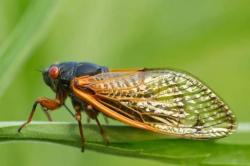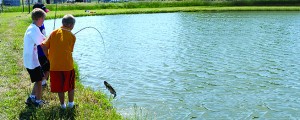17-year cicadas to provide feast for insect-eating birds
From The Birding Wire
For 17 years, a particular brood of cicada nymphs tunneled through the soil, sucked sap from roots, and grew from ant-like specks into bumblebee-sized nymphs. They will emerge by the thousands this spring in western Missouri and transform into winged adult insects, with male cicadas raising a raspy racket as they serenade females.
Periodical cicadas pose no threat to people and minimal threats to trees. But early summer will be abuzz with sound where 17-year cicadas emerge, said Rob Lawrence, forest entomologist for the Missouri Department of Conservation (MDC).
“In some places they make a pretty loud noise,” Lawrence said.
Periodic cicadas have distinctive red eyes, black bodies,
and are slightly smaller than the annual cicadas that
appear each year in late summer
The cicadas will begin emerging from the soil in early to mid-May, depending on how quickly weather conditions warm soil temperature. Current conditions could prompt the emergence to begin May 10 to May 12 in the Kansas City and St. Joseph areas, he said, though warm temperatures could hasten emergence.
Cicada nymphs will open half-inch holes in the soil surface as they emerge. Some may build three- to five-inch tall mud chimneys above their holes. Wingless nymphs will climb up on trees and other objects, shed their exoskeletons, and become adults with wings. That leaves brownish paper shells that resemble shed skins attached to trees, porches and posts.
Adults will climb or fly into trees. Males will join together to form choruses to attract females. Or consider it a jam session with instruments. Male cicadas rapidly flex two drum-like structures in their abdomens called tymbals. The flexing produces a click, and the clicks come so fast it produces a raspy hum. They sing during the day with the loudest drone rising during the hottest part of the day.
Annual cicadas appear each year and their drone ebbs and flows in the tree tops. But annual cicadas appear later in the summer than the periodical variety, Lawrence said. Periodical cicadas will be prevalent in late May and June; annual cicadas appear in July and August.
Periodical cicadas are so named because the broods emerge in 13-year or 17-year cycles. This 17-year brood emergence is occurring in an area that extends from Iowa to Texas and includes western Missouri and eastern Kansas. A 13-year emergence is also occurring in southeast Missouri and portions of other states. But the two broods are not expected to overlap.
Striking red eyes and blackish bodies distinguish periodical cicadas. Annual cicadas have greenish bodies, dark eyes and are about two inches long. Periodical cicadas are slightly smaller. Both types of cicadas include various species.
Periodical cicadas will not appear in all locations within the brood emergence area, Lawrence said. A field or yard that did not have trees 17 years ago, or perhaps even 34 years ago, would not have provided a place for females to lay eggs and for the nymphs to hatch and drop to the soil. Also, soil condition changes such as severe drought or construction disturbance could reduce the number of nymphs.
However, in some areas with favorable conditions, periodical cicadas could appear by the hundreds or even thousands. Such large, periodic emergences provide a feast for creatures that feed on insects. Wild turkeys will eat nymphs, so will fish where cicadas drop into the water. The large emergences are an evolutionary adaptation that lets the species survive by overwhelming predators with sheer numbers and a lengthy emergence cycle, Lawrence said.
Cicadas can affect trees. Females cut narrow slits in small branches and lay eggs in the slits. This can cause stress for limbs. Large, mature trees are generally not greatly affected. Although homeowners may notice some browned and broken branch tips, which is called flagging. Young trees can be harmed, and fruit trees can be stressed, because they have small branches favored by females for egg laying.
MDC foresters do not recommend using insecticides for cicadas. Small or newly-planted trees and shrubs can be covered with mesh and tied at the trunk. To reduce stress issues, homeowners should water young trees well during summer’s hot and dry months, Lawrence said.
Back in 1998, when the parents of this 17-year cicada brood were mating, an adjacent 13-year brood also emerged. But that overlap only occurs once every 221 years, Lawrence said.
This emergence will not be as large but will still be noisy. Adults emerging from the nymph shells will be soft at first. But within hours their wings and exoskeleton will dry and harden. They will then begin making the next generation that will sing in 2032.
“Once they get out, they’ll be singing in the trees for a while and make the racket,” Lawrence said.
For more information on periodical cicadas, visit mdc.mo.gov/node/12097 or magicicada.org. Video from a 2011 periodic cicada emergence in central Missouri is available at youtube.com/watch?v=Ve3NvNy17yk




